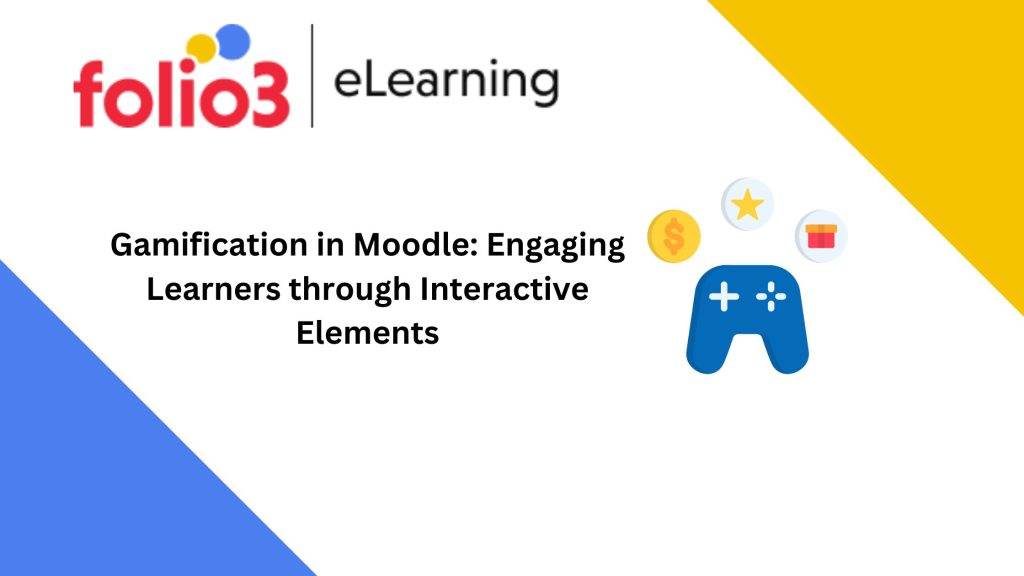
Executive Summary:
Gamification is a powerful strategy for keeping students interested in online learning environments like Moodle. Educators can give students a more engaging and delightful learning experience by introducing interactive elements and game mechanics into the lesson plan.
Introduction:
Keeping students’ interests and motivation high is a constant issue for instructors in online education. Traditional methods frequently fail to interest students in online learning environments, which has a negative impact on participation and learning outcomes. However, gamification has become a potent remedy in recent years. Teachers may improve the learning process and provide students a more engaging and delightful journey using interactive components and game dynamics. Moodle, a well-liked learning management system renowned for its adaptability and versatility, is one platform that has embraced this idea.
Gamification is the process of implementing game design concepts and mechanics in environments other than gaming, such as the classroom. Gamification in Moodle seeks to boost motivation, boost engagement, and create a deeper grasp of the subject matter by combining components like challenges, incentives, leaderboards, and badges. With its adaptable features and strong functionality, Moodle provides a versatile framework for using gamification techniques in online courses.

What is Gamification?
Gamification uses game design concepts and mechanics in contexts other than games, including marketing, education, and other fields. Increasing engagement, motivation, and participation, entails introducing aspects frequently seen in games, such as challenges, prizes, competition, levels, points, and achievements, into tasks or procedures.
Gamification aims to use the intrinsic enjoyment and motivation that games frequently offer to make non-game environments more engaging and participatory. People are likelier to actively participate, stay interested, and display behaviors that result in desired outcomes when introducing game-like features.
Benefits of Gamification in Moodle:
In order to promote and reward desired behaviors, gamification uses psychological factors including intrinsic motivation, the drive for achievement, social influence, and quick feedback. Gamification seeks to make jobs or processes more pleasurable, motivating, and ultimately more successful in accomplishing certain goals by using people’s innate desire for play and competition.
Gamification in Moodle has many benefits, such as:
- Enhanced Motivation
Gamification engages students’ innate motivation by giving them a sense of accomplishment and development. Moodle gamification techniques can encourage learners to perform well and achieve their educational goals by establishing clear goals, providing incentives, and posing challenges. Competition can be a strong motivator to promote active engagement and consistent effort, both with oneself and others.
- Increased Engagement
Moodle gamification’s interactive aspects encourage participation and deeper engagement. The learning process is made more engaging and enjoyable by features like quizzes, simulations, and virtual prizes, which grab students’ attention and motivate them to put more time and effort into their studies. Gamification’s interactive elements inspire students to become active learners rather than passive consumers of information.
- Personalized Learning Routes
Gamification enables teachers to customize learning routes to meet the needs of certain students. Thanks to Moodle’s monitoring and analytics features, instructors can gather information on students’ progress, pinpoint their areas of strength and weakness, and modify the course material as necessary. This individualized approach guarantees that pupils receive focused assistance and materials, maximizing their educational experience and encouraging improved comprehension and memory retention.
- Progress Tracking
Gamification in Moodle gives students rapid feedback, enabling them to assess their comprehension and progress in real-time. Rapid feedback and progress tracking. Thanks to this immediate feedback, students can pinpoint areas for growth and modify their learning approach. Additionally, progress monitoring through features like progress bars and leveling systems gives learners a visible picture of their success, inspiring them to continue their educational path and giving them a sense of accomplishment.
- Collaboration and Community Building
Moodle’s gamification features can encourage communication and cooperation among students. Features encouraging healthy competition and peer cooperation include leaderboards, rankings, and team tasks. Within the virtual classroom, learners can engage, impart information, and offer support to one another, forging a sense of community and camaraderie. This social gamification component can improve learning in general and build a welcoming learning environment.
Interactive Elements in Moodle Gamification:
The gamification of Moodle relies heavily on interactive components to make studying an enjoyable and immersive process for students. The advantages of certain essential interactive components utilized in Moodle gamification are listed below:
- Quizzes and Challenges
Challenges are interactive components that let students test their knowledge and abilities in a gamified setting. Multiple-choice, matching, and fill-in-the-blank questions, among others, are available in Moodle, allowing instructors to design interesting exams. Instant feedback on quiz responses helps students identify areas for growth and promotes learning. Timed tasks or quizzes can also create a sense of urgency and excitement, increasing attention.
- Progress Bars and Levels
Progress bars and leveling systems are visual representations of progress that give students a sense of success. Progress bars give students a clear picture of their overall progress in the course by graphically tracking their completion of modules, lectures, or tasks. On the other hand, leveling systems rank or classify students according to their accomplishments or accrued points. Leveling and progress indicators give students a sense of accomplishment and encourage them to keep progressing in the course.
Conclusion:
In conclusion, gamification in Moodle offers a fresh strategy for grabbing students’ attention and enhancing their learning. The intrinsic motivation of students can be tapped into and used to motivate them to succeed by educators by incorporating components like badges, leaderboards, quizzes, and progress bars. Moodle is transformed into a dynamic and engaging learning environment through gamification, which fosters engagement, teamwork, and a love of learning.

FAQs (Frequently Asked Questions)
Moodle’s gamification features are adaptable and may be used in various topic areas. Gamification can be customized to fit each topic’s unique learning objectives and content, whether it be math, language arts, science, or even professional training.
Through features like leaderboards and team challenges, gamification in Moodle promotes collaboration. Learners can coordinate with classmates, compete amicably, and compare their progress through discussion boards. This social connection fosters a sense of belonging and support within the educational context.
Yes, a lot of customization for gamification features is available in Moodle. Teachers can customize challenges, leaderboards, quizzes, and badges to fit the needs and objectives of their courses, as well as build custom quizzes and challenges.
Absolutely. Moodle allows gamification implementation in both group and individual learning environments. Students can go through personalized learning routes and receive specific prizes. They can work together, compete in teams, and achieve things together simultaneously.









